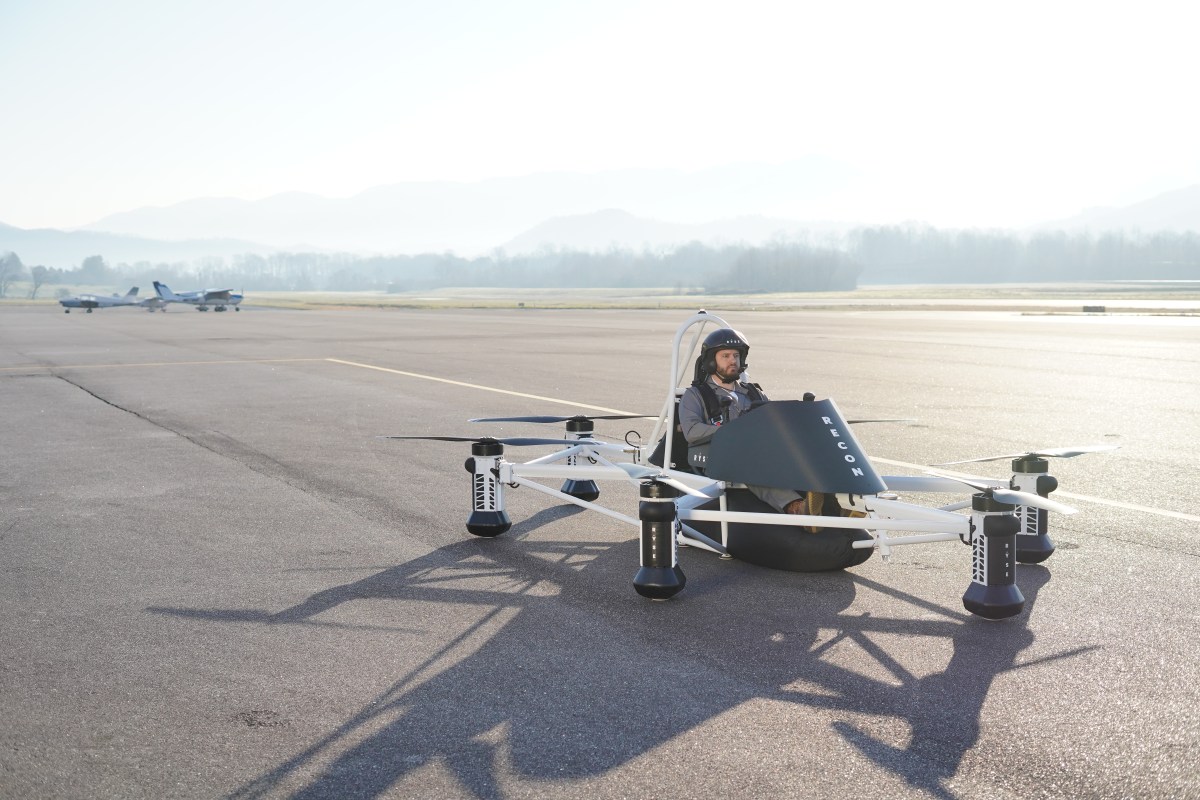Air taxis make up most of the hype surrounding eVTOLs — electric vertical takeoff and landing vehicles — despite their long path to market, steep upfront costs and plethora of regulatory hurdles. Ryse Aero Technologies, an Ohio-based startup building aircraft that are akin to flying ATVs, thinks eVTOL tech could be put to better use in a nearer-term market.
The company, founded in April 2021, recently opened reservations for its Recon ultralight aircraft — a one-seater eVTOL with land and water takeoff and landing capabilities and a maximum altitude of 400 feet. It’s powered by six independent motors, each with removable and rechargeable batteries.
“The idea was to make something extremely safe, extremely reliable that anybody could fly,” Ryse CEO Mick Kowitz told TechCrunch, noting that the Recon, weighing in at 286 pounds, is classified as an ultralight aircraft. That means it’s intended for single occupancy use, can’t be flown over congested areas and doesn’t carry heavy cargo.
It also means the Federal Aviation Administration doesn’t stipulate a set number of required training hours, so really, anybody could fly one.
“We give about an hour to two hours’ worth of training and you’re operating it,” said Kowitz.
So far, Ryse has built four prototypes, as well as a few pre-production vehicles that it’s currently testing with farmers. The startup sees many potential use cases for the aircraft — search and rescue, parks and recreation, oil and gas mining — but Ryse’s go-to-market strategy targets the agricultural industry in the United States.
“We’re really leaning into reduced crop compaction, reduced soil compaction, being able to get to your fields in the planting season,” said Kowitz. “You might have a blight out in the field, and the soil’s really wet, but you still gotta get out there. What farmers do is they drive as far as they can with their pickup truck or their ATV, and they walk in sometimes for two or three miles to where the problem is. The Recon can get them there rather quickly without a lot of compaction.”
Soil compaction, by the way, is caused by putting weight on soil via foot traffic, stock trampling, cars or other agricultural machinery. This compresses pores that would otherwise transport water or air, interfering with root growth and causing oxygen deficiencies.
Aside from avoiding soil compaction, Kowitz says the Recon can save farmers, ranchers and vineyard owners an even more precious commodity — their time. The Recon has enough battery capacity to fly 10 miles out and 10 miles back, which equals about 25 minutes of play at a top speed of 63 miles per hour.

Image Credits: Ryse Aero Technologies
“Your time is valuable, and in the agricultural world, a lot of people don’t necessarily value their time because it’s one commodity they think they have enough of,” said Kowitz. “In their farming life, they’ve also lived with the idea that time is what you spend walking out to that field, but if you can get places and save yourself an hour, two hours a day, what’s that worth to you?”
How about $150,000? That’s what the Recon will be going for once it’s out on the market. And that may seem like a pretty penny to a city slicker like you or me, but in the farming world, that’s nothing — at least according to Kowitz. A tractor alone could cost around $500,000, and many farms buy more than one.
While it’s still too early to know for sure how long a Recon might last in the field, Kowitz said Ryse has done environmental and vibration and sensor testing, and thinks the aircraft probably has a lifes pan of eight to 10 years.
There’s already demand for the Recon. Kowitz said Ryse has already earmarked about $15 million in future revenue from reservations, which means 100 potential customers have put their names down to lock in a delivery date.
The one possible snag the company faces is whether its aircraft can actually be used for commercial operations. The FAA’s ruling on ultralight aircraft, Part 103, stipulates the vehicle must be used for recreation or sport purposes only. Ryse said there are plenty of operators using this type of aircraft to make their business operations better without violating the rule, and the company has had conversations with the FAA regarding its use case “with no concerns.” The FAA didn’t comment specifically on Ryse, but the agency told TechCrunch it evaluates each one on a case-by-case basis.
Ryse must not be too worried about it, since the company is building out a production facility and aims to produce 10 vehicles per month throughout 2023, with deliveries beginning at the end of the year. The company has raised $5.5 million and hopes to raise another $25 million for its Series B round to help it ramp up production to 100 units per month by next year and into 2025.
